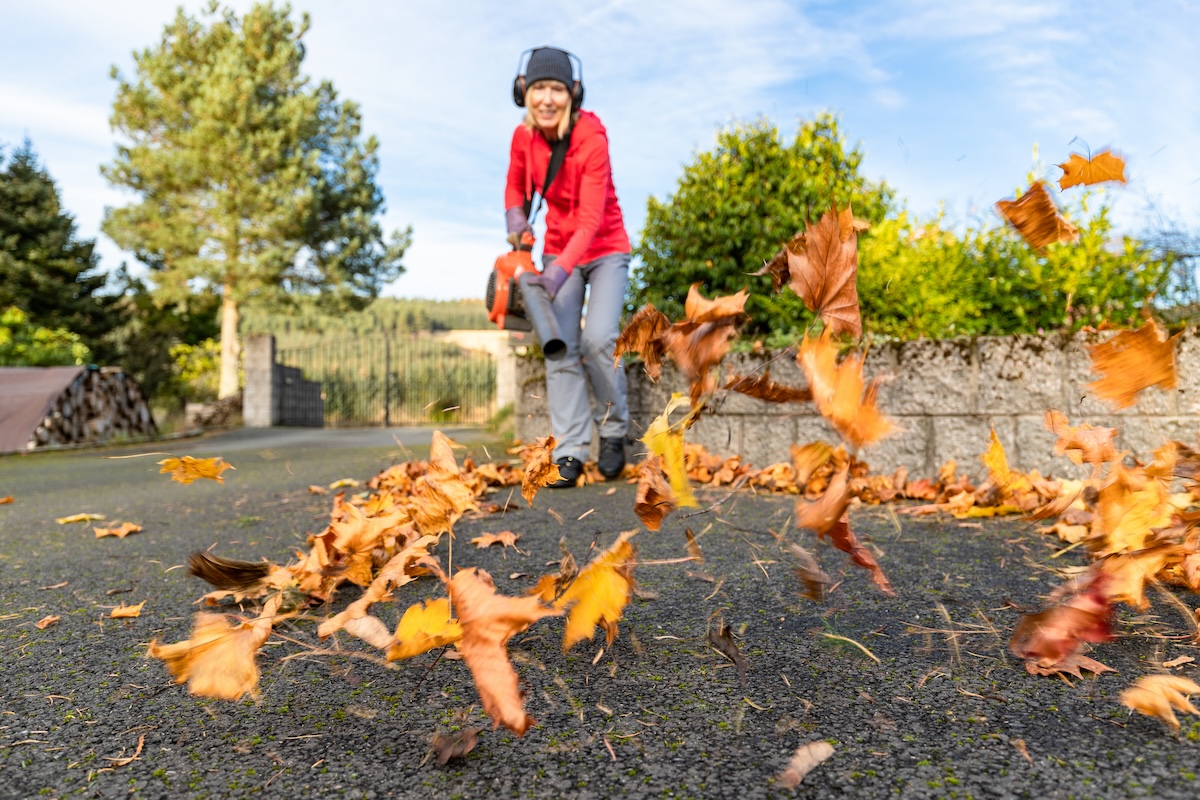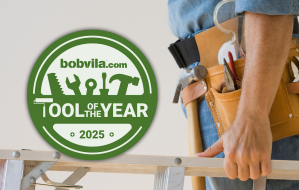

We may earn revenue from the products available on this page and participate in affiliate programs. Learn More ›
When the woods that backs up to my property dumps a carpet of red, orange, and yellow on my lawn, I turn to my trusty leaf blower to cast them back into the woods behind my house. This piece of outdoor equipment isn’t complicated to operate. Simply load it with a battery and pull the trigger to start blowing.
The part of operating a leaf blower that takes practice is learning how to use it without flattening your landscaping, blowing mulch across your yard, sending leaves onto your neighbor’s property, or draining the battery before the job is done. After years of fall cleanup, I’ve gotten clearing leaves with my blower down to a science.
1. Bad weather? Don’t bother.
Leaf-clearing is already a chore that none of us relish. Moving matted and wet leaves or battling windy conditions will make the work take longer and drain a cordless blower’s battery more quickly. Wait for fair weather conditions, when the leaves are dry and the wind is calm.
2. Always tote fully charged (and perhaps a couple extra) batteries for the blower.

Unless my favorite team’s playing and I’m looking for an excuse not to clear the leaves in my yard, I always make sure I have enough fully charged batteries to keep my blower humming until the yard is clear. My leaf blower gets around 30 minutes of runtime per battery when averaging moderate air speeds, less if I’ve got it set to full bore the entire time. Since it takes me close to an hour to get my ¼-acre yard cleared, I make sure I’ve got two fully charged 36-volt 7.5Ah batteries on hand to carry me through.
3. Don’t be that guy who wakes the neighborhood up with a noisy blower.
Nothing breaks the tranquility of an autumn morning like the whine of a gas-powered leaf blower. These machines can reach an ear-splitting 90-plus decibels from 50 feet away. It’s little wonder why firing up a gas-powered leaf blower might get you the side-eye from your neighbors. It’s also why a growing number of state and local governments are putting restrictions on when residents can use them or are just outright banning leaf blowers. If you have to use a gas blower, wait to do your leaf-blowing until mid-morning and limit your effort to an hour or two.
If you’re shopping for a leaf blower, I highly recommend purchasing an electric one. My cordless leaf blower is far quieter than comparable gas blowers and nearly as powerful. Cordless leaf blowers also are a lot easier to start, and you don’t have to fuss with mixing fuel and winterizing the engine.
4. Resist the urge to keep the blower on full throttle.
If you’re like me, you have a tendency to crank your power tools up to full speed when you use them. While having that extra gear to go to is nice, keeping the throttle wide open the entire time isn’t a good idea. Not only will you burn through the battery in record time, but those category 5 wind speeds it creates at full power will flatten flower beds and send airborne mulch, dirt, gravel, and other stuff you’d rather stay put. I save my blower’s top speed for blowing leaves over broad open areas of lawn and drop it to low speed when working around landscaping and gravel.
5. Don’t blow leaves into neighbors’ yards.
It’s easy to keep the leaves in my yard in-bounds with a rake that pulls leaves. It’s a lot tougher with a blower that pushes them. To maintain healthy neighbor relations, I start my leaf-blowing job by standing in my neighbor’s yard and blowing the leaves on the property line about 8 to 10 feet into my yard, working my way down the property line as I go. If I’m feeling generous, I’ll even blow some of the leaves from their lawn onto mine. Of course, you’ll want to give them a heads-up or ask permission before trodding onto their property.
6. Be strategic about clearing leaves around structures and fences.

Unless you’ve got an efficient plan for clearing autumn’s glory off your lawn, you’ll end up chasing leaves all over your yard, wasting time and battery life. You need a strategy for blowing leaves out of the tricky spots, too:
- Use buildings as a backboard. Leaves like to mound up against structures, where they’re hard to get at with a blower. But you don’t need to rake leaves out. Simply point your blower at the wall just above the leaves. The air will hit the wall, then rebound, pushing the leaves away from the structure, so you can get behind them and move them into the yard. This is a useful technique for leaves that collect around foundations and garage doors.
- Blow leaves, not gravel and mulch. Clearing leaves out of landscaping is a little trickier. You want to move the leaves while keeping the mulch and any gravel or stone in place. I like to drop the speed down a few ticks, then tilt the tip of the leaf blower so it’s not pointing at such a sharp angle to the ground. This position allows the air to move over the top of the landscaped area, so it moves the leaves and not the rocks or mulch.
- Mind the fence. Fences can be a challenge, especially if they’re chain link and the leaves can blow right through and onto your neighbor’s yard. Keep the blower up against the fence and aim the barrel so it’s parallel to the fence line. Blow the leaves back into your yard as you move down the fence line by sweeping the tip back and forth from the fence toward your yard.
7. Herd leaves into a central spot in the lawn.

Once you’ve gotten the leaves out from around the house and landscaping, it’s time to move and gather them. I’ve found these tips helpful to make the task easier.
- Leaf roundup. As you approach mini-piles in your lawn, crank up the speed and move the blower tip from side to side to herd them to the curb, woods, center of your lawn, or wherever you plan to collect them. As the leaves start to pile up, raise and lower the tip to move the top layer, then the bottom layer, forward.
- Create an edge. As you move leaves to their final destination, create a defined edge to the gathered pile. Move up and down the line, herding the line of leaves forward about 5 or 6 feet with each pass.
- Make a pile. If you’re blowing the leaves to a curb, keep moving that leaf edge forward to the road. If you’re collecting the leaves, pick a collection spot near the center of the yard and move leaves from different parts of your yard to it. Once all the leaves are in the center, work around them to create a pile.
8. While you have the leaf blower out, use it for other outdoor cleanup tasks.
I use my blower to blow dirt and leaves out of my garage, return mulch to my landscaping after a heavy rain, and clear grass clippings off my walk and patio post-mowing. It’s far quicker than using a broom. I’ve even used it to dry off my car after washing it. This is where having an extra battery in your pocket comes in handy.
